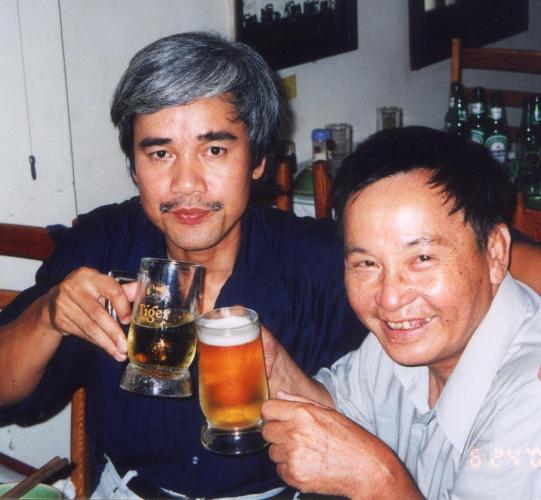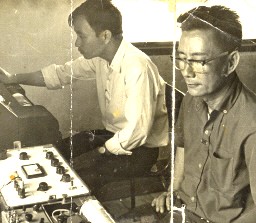 |
Gấu có những kỷ niệm khủng khiếp về cái đói, khi còn là 1 thằng bé nhà quê Bắc Kít. Có những kỷ niệm, là của ông bố của Gấu. Thí dụ cái chuyện bà nội của Gấu, chồng chết sớm, nuôi đàn con, có nồi thịt, bắt con ăn dè ăn xẻn thế nào không biết, nồi thịt biến thành nồi ròi. Vô Nam, phải đến sau 30 Tháng Tư, Gấu mới được tái ngộ với cái đói, những ngày đi tù VC.Thê lương nhất, và cũng tiếu lâm nhất, có lẽ là lần Gấu Cái đi thăm nuôi, lần đầu, sau mấy tháng mất tiêu mọi liên lạc với gia đình. Cái tật viết tí tí, không bao giờ dám viết ra hết, kỷ niệm, hồi nhớ, tình cảm… nhất là thứ kỷ niệm tuyệt vời, nhức nhối.... là do cái đói gây nên! 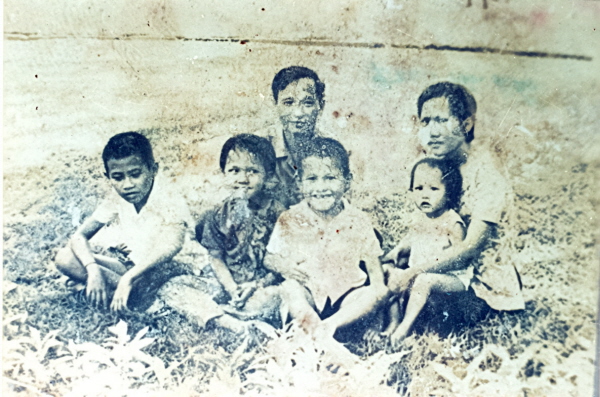 Vợ chồng con
cái nhà Gấu, liền sau 30 Tháng Tư 1975: Đói tàn khốc! Câu chuyện tiếu lâm về Bác, do
Gấu phịa, và kể cho mấy anh quản
giáo Đồ Hoà nghe, là vào thời gian Gấu vừa thoát “khổ nạn trong khổ
nạn”, ra
khỏi tổ trừng giới, được trả về đội, và được đi lao động, và do có tí
tiền gia
đình gửi cho, bèn mua chức Y tế Đội, tối tà tà đi từng lán, ghi tên
trại
viên khai bịnh, sáng hôm sau, sau khi chào cờ, đọc tên, dẫn qua khu
bệnh xá. Nhờ lần thăm nuôi đầu tiên, nhờ
tiền gia đình gửi cho, cuộc đời tù của
Gấu thay đổi
hẳn. Buổi tối, Gấu thường la cà mấy lán, dự tiệc trà, thường là do mấy
trại
viên ban ngày có gia đình thăm nuôi mời. Để đáp lại, Gấu bèn trổ nghề
kể chuyện
tiếu lâm, quay phim chưởng. Danh tiếng vượt khỏi đội, tới mấy đội khác,
rồi tới
tai mấy ảnh. Và được mấy ảnh mời, cho ngồi nhậu chung, kể chuyện tiếu
lâm. So với câu chuyện về Bác, của NQL, cùng một một dòng, "hậu quả của hậu quả”, nhưng chuyện của Gấu, thì quá thường, so với của NQL. Nay xin kể ra đây, cho rảnh nợ! Trước
khi kể Gấu cũng rào đón với mấy Quan quản giáo, đúng hơn, mấy Đấng
TNXP, đừng có bắt tội thằng kể, và được OK. Theo như truyền kỳ, thuở đó, thuở đó, Miền Bắc có một đội banh vô địch, đánh đâu thắng đó, và lần đó, qua Âu Châu dự World Cup, mang được Cup về cho xứ Mít. Trong bữa tiệc chia tay, ông bầu, bị đám báo chí Tây Phương phục rượu, xỉn quá, bèn phụt ra bí quyết: -Mỗi khi ra trận, tui kêu cả đám cầu thủ tới, dặn một câu... thế là tụi nó đá như điên. -Câu gì mà ghê thế ? Thư tín 1 NQL tả chân quá siêu. Liên minh
các chế độ hà khắc tạo ra những
con người ẩn ức, để mặc bản năng hướng dẫn, đọc thấy thương, không thấy
tục. "Nhà
phê bình cần tri thức và bản lĩnh. Tôi thấy mình có cả hai." Phạm Xuân
Nguyên đã nói một câu rất ngạo như thế. Bảnh thật.
Phán như thế mới là phán, và chẳng cần “điều tiết” làm khỉ gì nữa. NQT
Hai
bài viết
của NDB, về Ngọc Giao, và về Trịnh Cung [trong vụ ‘tham vọng chính trị
của TCS’],
đều có vấn đề. Từ từ, Gấu sẽ giải thích
sau, và sẽ minh họa, bằng chính những kỷ niệm
mà Gấu
đã kinh qua, thí dụ như cái vụ mân mê “bảo vật Nga” tuyệt vời!
!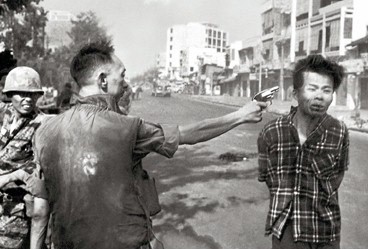
Vietcong Execution, The photo of the execution at
the hands of Vietnam's police chief,
Lt. Colonel Nguyen Ngoc Loan, at noon on Feb. 1, 1968 has reached
beyond the
history of the Indochina War - it stands today for the brutality of our
last
century. October 2004 Minh bạch lịch
sử. Qua câu phán
của Faas, trưởng phòng hình ảnh AP, Sài Gòn, trước 1975: Hay, câu của
Adams, tác giả bức hình: 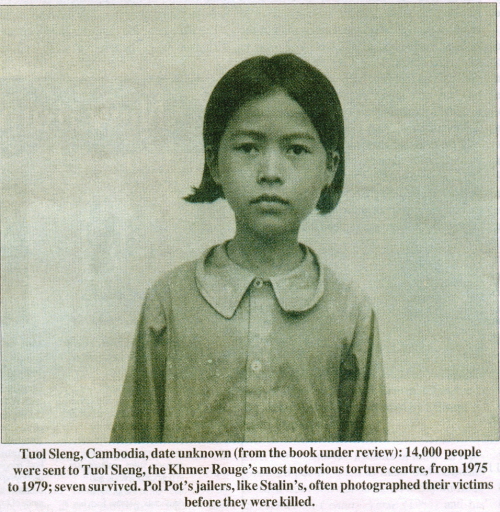 Quản giáo,
cai tù Pol Pot, giống như của Stalin, có cái thú trước khi làm thịt ai
thì cho
chụp hình làm kỷ niệm "Who
are you who will read these words and study these photographs, and
through what
cause, by what chance, and for what purpose, and by what right do you
qualify
to, and what will you do about it?" Tỏa Sáng Ðộc Ác
Anh
là thằng chó nào, kẻ sẽ đọc những từ này, nghiên cứu những bức hình
này, và qua
lý do gì, bởi cơ may nào, và vì mục đích chi chi, và bằng cái quyền chó
nào mà
anh cho phép xứng đáng, đủ tiêu chuẩn để làm những chuyện như trên? 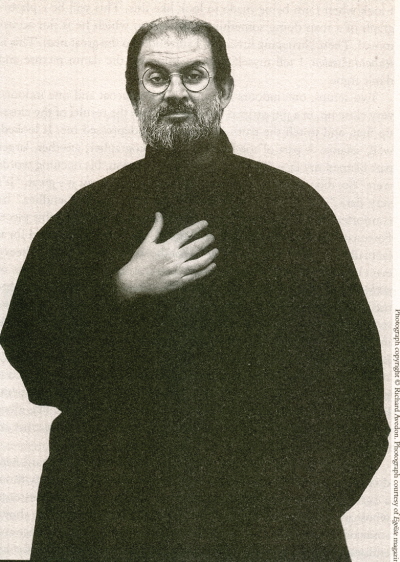 Bị chiếu tướng Note: Bài viết
này, về "bị chụp hình", tuyệt! There is something predatory about all photography. The portrait is the portraitist's food. In a real-life incident I fictionalized in Midnight's Children, my grandmother once brained an acquaintance with his own camera for daring to point it at her, because she believed that if he could capture some part of her essence in his box, then she would necessarily be deprived of it. What the photographer gained, the subject lost; cameras, like fear, ate the soul. Có cái gì tựa
như là “ăn sống con mồi”, nếu nói về chụp hình. Bức hình là thức ăn của
nhiếp ảnh
gia [hãy nhớ câu của Eddie Adams, trên]. Ui chao, nhìn
cái hình vợ chồng con cái Gấu, thì mới ngộ ra chân lý: VC ăn, thịt
sống, còn
anh thợ chụp hình ăn, linh hồn!
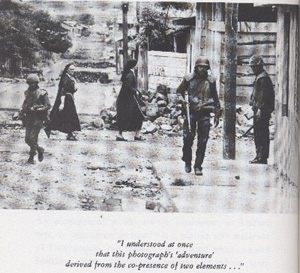 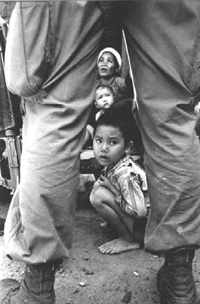 Bạn nhìn bức
hình trên, đọc chú thích của Roland Barthes [Tôi hiểu liền lập tức,
'cuộc phiêu
lưu' của tấm hình - của Koen Wessing, Nicagagua, 1979, trích từ cuốn
Roland
Barthes: Camera Lucida: Suy tưởng về chụp hình, Reflections on
Photography, bản
tiếng Anh của Richard Howard - là do sự đồng-hiện diện của hai phần
tử], và so
sánh với bức của Henri Huet. 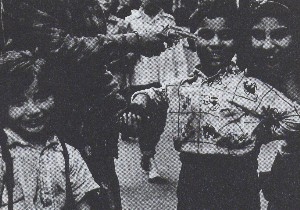 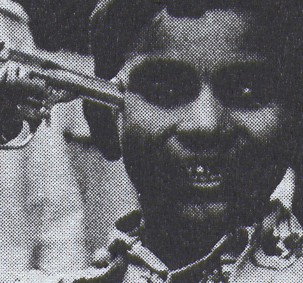 Tôi đếch thèm để ý đến khẩu súng, mà là, hàm răng sún của chú bé! WILLIAM KLEIN: LITTLE Nguồn Mẩu trên, với
hình ảnh kèm, từ 1 trang TV cũ, được GNV sử dụng ở đây, để giới thiệu
một bài
viết thật tuyệt vời về hình ảnh, trên tờ TLS số 11 Tháng Ba, 2011: Hình Ảnh. Những Kẻ Ðem Tin Xấu. Alex
Danchev đọc cuốn The Cruel Radiance
[Tỏa Sáng Ðộc Ác]. Hình ảnh và bạo lực chính trị. Bài viết nhắc
đến những nguồn trứ danh về hình ảnh, từ “hào quang” của Walter
Benjamin, tới
Susan Sontag, nhưng… quên Roland Barthes và cuốn trứ danh của ông! Ðọc caption
tấm hình dưới đây, G bất giác nhớ đến
tướng
NNL, và bức hình trứ danh của ông, mà theo như Gấu - khi đó làm
Radiophoto-operator
cho UPI, là 1 trong những người đầu tiên được nhìn nó, trên máy chuyển
hình của
AP đặt ngay kế bên máy của UPI - được biết, ông tướng đã cho vời ký giả
ngoại
quốc tới, để chứng kiến ông xử tên tên VC.   Quản giáo, cai tù Pol Pot, giống như của Stalin, có cái thú trước khi làm thịt ai thì cho chụp hình làm kỷ niệm 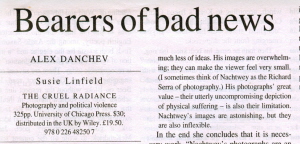 PHOTOGRAPHY Susie
Linfield THE CRUEL
RADIANCE Photography
and political violence 325pp. University
of Chicago Press. $30; distributed in the UK by Wiley. £19.50.
9780226482507 Susie
Linfield takes as her title, and her text, a passage from James Agee.
In the
remarkable work of lyric reportage that he fashioned to accompany
Walker
Evans's equally remarkable photographs of the poor sharecroppers of
Alabama in
the Great Depression, Let Us Now Praise
Famous Men (1941), Agee wrote: For in the
immediate world, everything is to be discerned, for him who can discern
it, and
centrally and simply, without either dissection into science or
digression into
art, but with the whole of consciousness, seeking to perceive it as it
stands:
so that the aspect of a street in sunlight can roar in the heart of
itself as a
symphony, perhaps as no symphony can: and all of consciousness is
shifted from
the imagined, the remissive, to the effort to perceive simply the cruel
radiance of what is. For Agee,
the crucial agent of influence here is the camera. He continued: "This
is
why the camera seems to me, next to unassisted weaponless
consciousness, the
central instrument of our time". Linfield
takes up where Agee left off. It is the camera, she argues, that has
done so
much to globalize our consciences; the camera that has brought us the
twentieth
century's bad news. Her work is at heart a serial reflection on our
visual
encounter with human suffering: the suffering of strangers. It speaks
to our
response, and our responsibility - "the opportunity, and the ability,
to
be moved by the plight of others". She adopts the question framed by
the
philosopher Richard Rorty, "Why should I care about ... a person whose
habits I find disgusting?" and his suggested answer: "Because her
mother would grieve for her". Linfield's contention is that the
photograph
is a tutorial in the grievous and the grievable. "The camera has been a
key tool - perhaps the key tool - in enabling such empathic leaps." The
Cruel Radiance is a treatise on moral witness and empathic leaps: a
book of
brief lives - grief lives - on both sides of the camera. Put
differently, it is a book about the ethical freight of that little
sliver of
sentience, the photograph, sparingly but discriminatingly illustrated.
Inescapably, it is also about the bearer of the bad news, the
photographer.
Linfield examines three of the masters: "the optimist", Robert Capa;
"the catastrophist", James Nachtwey; and "the sceptic",
Gilles Peress. Each in his own way is exemplary, as their sobriquets
serve to
indicate, and her treatment of them is exemplary, too, for its
impassioned
clarity. John Berger is lauded in this work as "the most morally cogent
and emotionally perceptive critic that photography has produced". For
Linfield,
criticism is a high calling. If these attributes are the test, she is
equal to
it. There is a scrupulous attentiveness to her looking-in and
arguing-out. The case
study of Capa is a thoroughgoing revaluation. For Linfield, Capa was
something
more than the wild rover, if-your-pictures-aren’t-good-enough-you'
re-not-close-enough
debonair existentialist of the combat zone. For the world's greatest
war
photographer, he was surprisingly uninterested in carnage, or for that
matter
in battle. What drove him was not atrocity but possibility - "the lived
knowledge of political possibility". His interest was, fundamentally,
the
moralist's. Capa was a moralizer, one might say, as opposed to a
demoralizer.
"His photographs record the twentieth century's moments of militant
humanism", resumes Linfield in a moving peroration: and they do this by
how he, working at the time, made them and by what we, in the present,
bring to
them. His images are antifascist because they document a flawed, deeply
scarred
humanity, and because they honor rather than scorn those flaws and
those scars.
Capa's photographs show us that human beings suffer, and make us want
to know
why; they show us that human beings endure, and make us want to know
how. They
show us that striving for a more-just world can sometimes succeed but
more
often fails, yet that to do so is never absurd or inconsequential. The case
study of Capa's successor, James Nachtwey, is the best thing yet
written on
that remorseless ascetic. As a bringer of bad news, Nachtwey is
unparalleled.
At the beginning of his signature collection, Inferno (1999), he quotes
Dante:
"Through me is the way to join the lost people". Linfield is a
disquieted admirer; she wrestles with her scruples and his detractors
(most
productively with the philosopher J. M. Bernstein). Nachtwey's
photographs are didactic .... [His] particularly potent blend of
graphic,
sometimes disgusting subject matter and
bold, imposing compositions make it hard to maintain, or even
establish, a free
rein of emotions, much less of ideas. His images are overwhelming; they
can
make the viewer feel very small. (I sometimes think of Nachtwey as the
Richard
Serra of photography.) His photographs' great value - their utterly
uncompromising depiction of physical suffering - is also their
limitation.
Nachtwey's images are astonishing, but they are also inflexible. In the end
she concludes that it is necessary work. "Nachtwey's photographs are an
odd, compelling combination of misery and serenity, of edginess and
supreme
control, of horrible content and stylized form: they are, in short,
visual oxymorons.
But the perfection of their compositions - their so-called beauty -
should not
deflect us: Nachtwey's photographs are brutal, and they show us more
than we
can bear. But not more than we need to see." As if to underline her
argument, the examples chosen as illustrations of his work are not to
be seen
in this book. What appears instead is a grey box, with a bare legend:
"James Nachtwey Studio denied permission to reproduce this photograph.
It
can be found in James Nachtwey, Inferno,
p.174". Revealed and concealed, the starving man of the Sudan and the
hanging man of Afghanistan continue to perturb. If photographs teach us
about
our failure to comprehend the human, as Linfield believes, James
Nachtwey's
photographs help us to come closer: to fail better. The pages on
Nachtwey's contemporary Gilles Peress are no less searching. "For
Peress", Linfield observes, "photography 's a way to think about the
world." He is a philosopher with a camera. He is also a democrat, and a
humanitarian. Photographs are open documents, he has said, "where half
of
the text is in the reader", a proposition brilliantly illustrated
by an off-centre, out-of-kilter group portrait of the victims of the
Shah of
Iran's secret police, bearing the scars (and the prostheses) of their
torture;
and an oddly tender still life of bare feet, shoes and socks, left for
dead in
a Kosovan field. Peress contends that every image has four authors: the
photographer, the camera, the viewer, and reality. In Linfield's words,
his genius
has been ... to incorporate a critique of photography's objectivity
into that
obstinate bit of bourgeois folklore formerly known as truth. He
embraces
postmodern skepticism, but uses it to enlarge photographic
possibilities rather
than to discredit the medium. Peress has taken the alienated
sensibility
typical of, and prized by, modem photographers and fused it to a
passionate
engagement with the world outside himself. It is not
too much to suggest that Linfield herself wishes to do something
similar. Her
book is at once a meditation on the democratic possibilities of the
medium and
an intervention in the somewhat impoverished critical discourse about
it. Not
for nothing is the opening chapter entitled "A Little History of
Photography Criticism; or, Why Do Photography Critics Hate
Photography?".
The first part of this title summons the ghost of Walter Benjamin, and
his
"Little History of Photography" (1931); the second targets one critic
in particular, together with her epigones, "the post modems". If John
Berger is the benchmark, Susan Sontag is the bête noire. By her own
admission,
Linfield is writing against Sontag, against coolness, against
detachment,
against condescension - against the critical tone set by On Photography
(1977).
Linfield pits Pauline Kael on the movies against Sontag on photography
and
finds Sontag wanting. (Impossible to imagine a Sontag collection called
Kiss
Kiss Bang Bang.) The tone, and the reservation, are neatly encapsulated
in
Sontag's last utterance on the subject, "Photography: A little summa"
(2003). "A photograph may be telling us: this too exists. And that. And that. (And it
is all 'human'.) But what are we to do
with this knowledge - if indeed it is knowledge, about, say, the self,
about
abnormality, about ostracized or clandestine worlds?" The Cruel
Radiance
is an attempt to answer that question. As criticism, it is a work of
deep
distinction. It will surely become part of the history of its field; in
its own
comer, Sontag's Regarding the Pain of Others (2003) suffers by
comparison. As
treatise, it is not quite an integral whole. Betraying its origins, it
remains
a series of essays, or investigations. (Why is the literature of
photography so
essayistic? Does the sliver insist on the short form?) There are
lacunae.
"Perhaps the camera promises a festive cruelty", Judith Butler has
suggested, of the images of Abu Ghraib; she writes provokingly of "the
moral indifference of the photograph, coupled with its investment in
the
continuation and reiteration of the scene as a visual icon". Thus are
Sontag's theories dealt with. Butler's are still current. Linfield
joins a
select company. In the
preamble to Let Us Now Praise Famous Men, James Agee posed a series of
unforgettable questions to his readers. Susie Linfield bids to do the
same.
"Who are you who will read these words and study these photographs, and
through what cause, by what chance, and for what purpose, and by what
right do
you qualify to, and what will you do about it?" In the preamble to Let
Us
Now Praise Famous Men, James Agee posed a series of
unforgettable
questions to
his readers. Susie Linfield bids to do the same. "Who are you who will
read these words and study these photographs, and through what cause,
by what
chance, and for what purpose, and by what right do you qualify to, and
what
will you do about it?"
|
